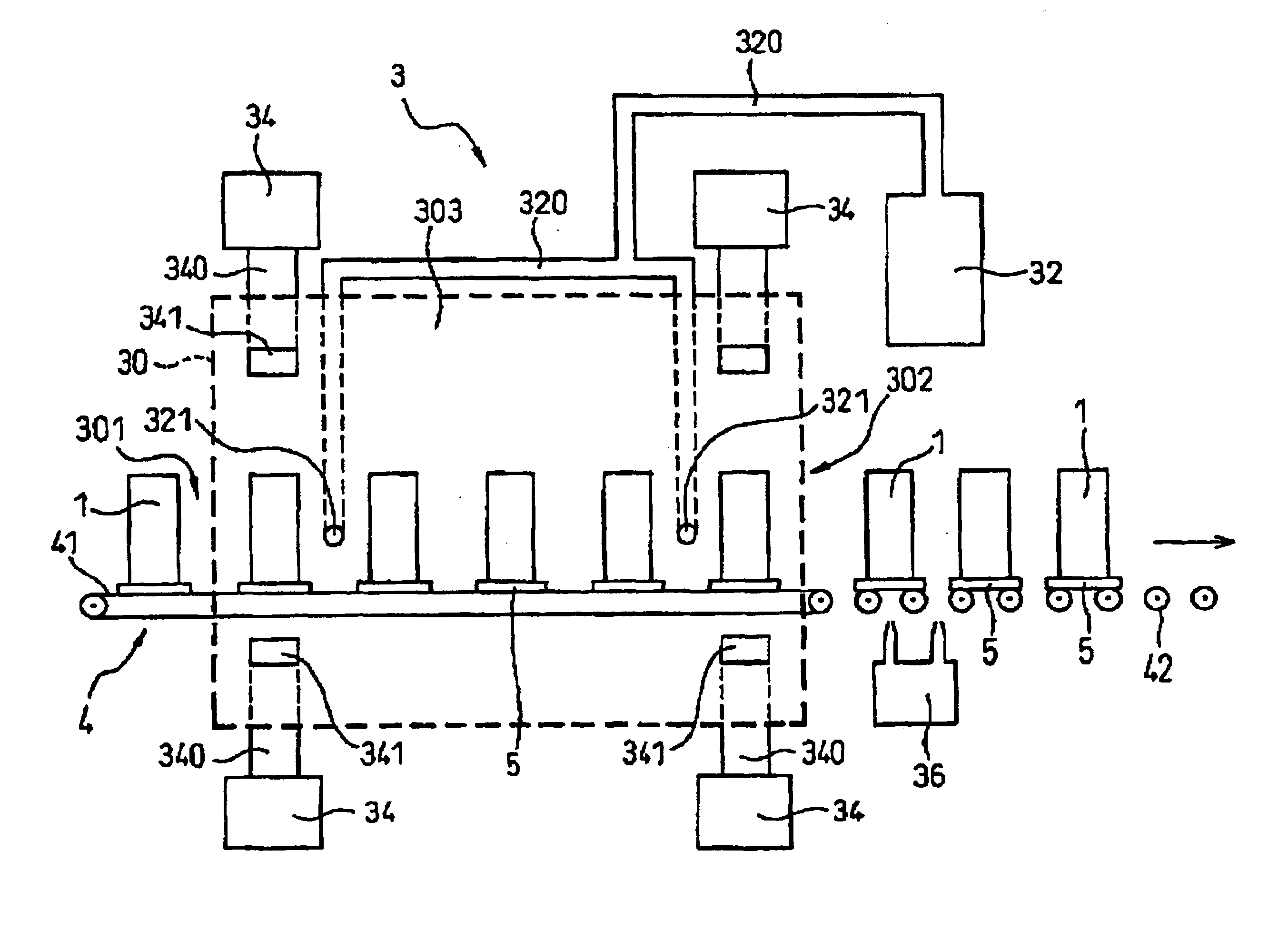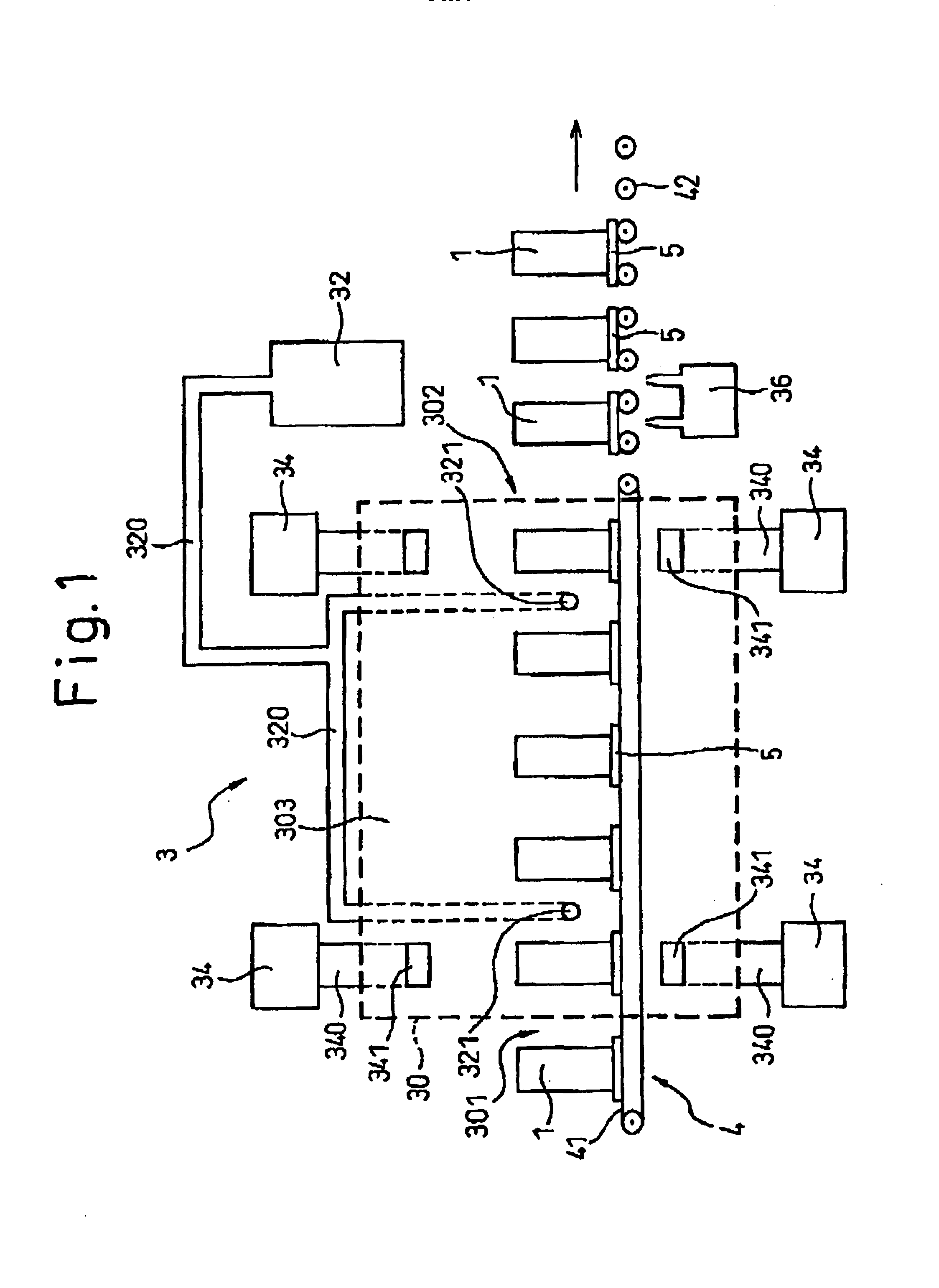Method of fabricating honeycomb body
a technology of honeycomb and body, applied in the field of method of fabricating at least a honeycomb body, can solve problems such as equipment malfunction, and achieve the effects of further suppressing variations of microwave density between the upper and lower sides of the drying bath
- Summary
- Abstract
- Description
- Claims
- Application Information
AI Technical Summary
Benefits of technology
Problems solved by technology
Method used
Image
Examples
first embodiment
[0067
[0068]A method of fabricating at least a honeycomb body and a drying system according to an embodiment of the invention will be explained with reference to FIGS. 1, 2(a) and 2(b).
[0069]This embodiment, as shown in FIGS. 2(a) and 2(b), represents a method of fabricating a honeycomb body 1 of ceramics including a multiplicity of cells 10 arranged in the shape of a honeycomb with a plurality of cell walls 11 having a thickness t1 not more than 0.125 mm. The honeycomb body according to this embodiment, as shown in FIGS. 2(a), and 2(b), includes a plurality of square cells 10 and a cylindrical outer peripheral skin portion 12 having a thickness t2 not more than 0.5 mm. The aforementioned shapes of the cells and the whole honeycomb body can be changed in accordance with a specific application.
[0070]In the method according to this embodiment, the argillaceous honeycomb body 1 produced by extrusion molding is dried by being exposed to a high-humidity ambience of not less than 70% in hu...
second embodiment
[0094
[0095]According to this embodiment, a test is conducted to determine the correlation between the humidity and the quality of the outer peripheral skin portion by changing the humidity by the amount of the high-temperature steam introduced to the drying bath 30 using the drying system 3 according to the first embodiment. Except for humidity, the same conditions are employed as those for the first embodiment.
[0096]The test result is shown in FIG. 3. In FIG. 3, the abscissa represents the internal temperature of the drying bath 30, and the ordinate the cracking / wrinkling defective fraction of the outer peripheral skin portion. In each session of the test, 20 honeycomb bodies were processed, and by determining the percentage of those honeycomb bodies which have developed even a small cracking or wrinkling as defective products, the ratio of the number of defective products is calculated as a defective fraction.
[0097]As seen from FIG. 3, it has been found that the effect of cracking...
third embodiment
[0098
[0099]According to this embodiment, a test is conducted to check for any malfunction due to water stagnation during the drying process by changing both the porosity of the conveyance tray 5 and the internal humidity of the drying bath 30 in the first embodiment. The conditions other than the porosity of the conveyance tray 5 and the humidity in the drying bath 30 are similar to the corresponding figures in the first embodiment.
[0100]The test result is shown in FIG. 4. In FIG. 4, the abscissa represents the porosity of the conveyance tray, and the ordinate the humidity of the drying bath. One session of the drying process is conducted under each condition, and the graph is plotted by indicating with X a case in which even a small elution occurs from the cell wall or the outer peripheral skin portion, and with ∘ a case in which no such elution occurs.
[0101]As seen from FIG. 4, the higher the humidity, the easier the elution occurs. In the case where the humidity is at least 70%, ...
PUM
| Property | Measurement | Unit |
|---|---|---|
| thick | aaaaa | aaaaa |
| porosity | aaaaa | aaaaa |
| porosity | aaaaa | aaaaa |
Abstract
Description
Claims
Application Information
 Login to View More
Login to View More - R&D
- Intellectual Property
- Life Sciences
- Materials
- Tech Scout
- Unparalleled Data Quality
- Higher Quality Content
- 60% Fewer Hallucinations
Browse by: Latest US Patents, China's latest patents, Technical Efficacy Thesaurus, Application Domain, Technology Topic, Popular Technical Reports.
© 2025 PatSnap. All rights reserved.Legal|Privacy policy|Modern Slavery Act Transparency Statement|Sitemap|About US| Contact US: help@patsnap.com



